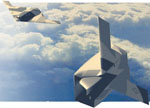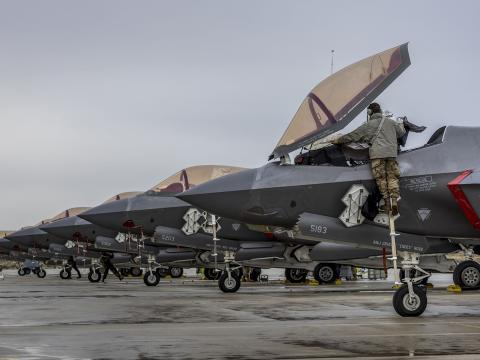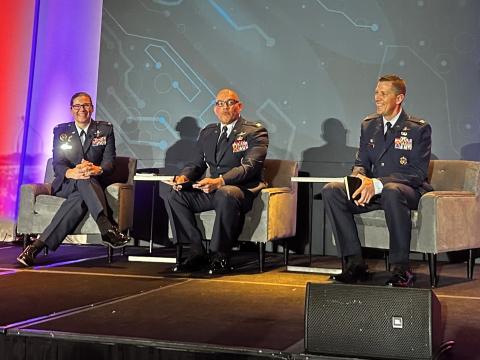The Shape Of Wings To Come
Morphing capability would offer flexible tactical options. 
Lockheed Martin Aeronautics Company’s Advanced Development Programs sector is proposing a morphing wing design that can be locked into either an expanded or contracted position. Key to enabling this capability is the aircraft’s skin, which is made out of a shape memory polymer.
Researchers at the Defense Advanced Research Projects Agency (DARPA),
The agency decided to revisit the morphing aircraft concept in April 2002 with a three-phase program. The first two phases of the MAS program aimed at attaining four technical goals: innovative, active wing structures that change shape; integration and aeronautical use of advanced sensors, skin and structure materials, internal mechanisms and distributed power sources; advanced capabilities for the military community; and advanced shape-changing materials, efficient actuators and sophisticated, smart mechanisms.
For the one-year first phase of the project, DARPA awarded contracts to three firms, and each took a unique approach. Palmdale, California-based Lockheed Martin Aeronautics Company’s Advanced Development Programs section, also known as Skunk Works, designed an aircraft wing that can fold and be locked in two positions. The structural material, called a shape memory polymer, becomes pliable when stimulated with a moderate amount of current, then returns to a solid state when the stimulus is terminated.
Engineers at NextGen Aeronautics Incorporated,
Raytheon Missile Systems,
Weisshaar explains that creating a truly morphing aircraft requires that changes can be made in the wing area, span, sweep and thickness. While a minimum of wing area is needed to fly at speeds of Mach 2 or Mach 3, a larger wing is necessary for landing. “So you already have a problem. If you want to go really fast, then you can’t land very efficiently. What we said is ‘let’s change the wing area,’ and it turns out that [an increase of] 50 percent is a pretty good number. If you could change the wing area in flight by 50 percent, you can do lots of different things. You can operate efficiently at high speeds and at low speeds,” he relates.
Flying high and slow—an appealing capability for reconnaissance missions—requires a wide wingspan in addition to a larger wing area, so increasing the wingspan by 50 percent to 75 percent also multiplies applications. “The aircraft could hang out at high altitudes, but it could still respond supersonically or at least high subsonically to a threat. This is a big deal for the military,” Weisshaar notes. “Our goals in this morphing program were to get big area changes, as big as 50 percent; big span changes—50 percent to 75 percent—and then also sweep changes because that is something that you want for high speed.”
During the first phase of the program, contractors were required to define the concepts fully and then to test and demonstrate critical components. All three companies were successful to a major degree, he states.
DARPA chose to pursue work with Lockheed Martin and NextGen Aeronautics for the 18-month second phase of the project, opting to concentrate on unmanned aerial vehicles (UAVs) rather than including cruise missiles in the effort. The goal during this stage was to develop the remaining companies’ designs and demonstrate them in an aeronautical environment. To conduct the examinations, prototype planes were taken to the transonic dynamics tunnel at NASA’s
“The issue here is not so much aerodynamics, because you can predict lift and drag pretty well. It wasn’t even structure loads or static loads, because you can pretty well predict those. The real issue was could you build a system that could transition radically from one shape to another very, very different shape without the whole thing coming apart,” Weisshaar explains.
Using a model that was half the size that DARPA had in mind for the potential real-world aircraft, the agency team determined that the morphed wings could hold their shapes within a couple of degrees. In addition, the wings could be unlocked at speeds of nearly Mach 1. The tests not only included low and high speeds but also low and high altitudes—from sea level to 50,000 feet.
After some minor adjustments to address billowing problems, Lockheed Martin demonstrated that its design skin could stretch 100 percent. And, while NextGen Aeronautics’ original design resulted in a few tears in the skin when loads were increased, a minor design alteration resolved the problem, and the plane reached speeds of Mach 0.9 without additional problems. “The bottom line was that we did it,” Weisshaar states.
Larry Dilger, manager, Morphing Air Structures, Lockheed Martin Aeronautics, explains that his group’s work on the project began with identifying the key enabling technologies that would result in a revolutionary improvement in aeronautical performance. The team, which currently consists of 15 people, singled out three enabling technologies as crucial to developing the design. The first was the airplane’s skin, which is necessary to conceal discontinuities on aircraft such as hinges and doors that restrict performance.
Dilger says that although the technology is still somewhat in the embryonic stage, Lockheed Martin developed a shape memory polymer that resembles fiberglass. It is about an eighth of an inch thick and is embedded with elements that allow current to pass through it to allow shape changes.
The actuation of structures was the second key enabling technology the team identified. “You might imagine that folding a wing is not a trivial task, and traditionally rather large, very heavy actuation mechanisms were used to do that. For example, a carrier-capable aircraft has wing-folds on it that are very, very heavy—not very efficient for today’s aircraft,” Dilger offers.
The third capability the team identified was technologies that would enable control of the aircraft in flight. “One of the most exciting enabling technologies that we’re dealing with on this program has to do with adaptive flight controls. A morphing aircraft can really do the same thing as well as a variety of aircraft. For example, a U-2 flies high and slow for long hours and gathers a lot of data. An F-117 or an F-22 flies fast and is highly lethal. Both of those airplanes have optimized designs.
“What morphing aircraft structures represent is the ability to become either a persistent reconnaissance platform or a highly lethal combat platform. And, there are many other missions—for example, homeland defense, border patrol and harbor patrol,” he notes.
The company successfully developed these three key enabling technologies for the first phase and validated them during the second phase of the DARPA project, but Dilger admits that work remains. Currently, these capabilities are at technology readiness level (TRL) 2 or 3 and will need to mature to TRL 7 or 8 before they will ever excite a military general, he says. “That’s the biggest challenge—getting people to believe it’s possible,” he adds.
 |
| NextGen Aeronautics’ morphing aircraft design features wings that can continuously change shape to increase the wings’ surface area. |
Jay Kudva, president and chief executive officer, NextGen Aeronautics, explains that the toughest technical challenge in the company’s concept was developing airplane skins that can stretch an enormous amount yet continue to handle loads without tearing. “Nobody’s ever done a flexible skin that expands this much—ours expands more than 100 percent for landings—and still [can] take air loads and fly,” Kudva claims.
Proof of the firm’s design concept was attained this summer apart from the DARPA program. The company constructed a 100-pound jet-powered remote-control model that completed a successful flight in August. “We tested this a couple of times late last year and early this year. We were not successful in landing it well at that time. Let’s say we had an unconventional landing a couple of times. But on August 1st [2006], we flew it and we successfully showed, for the very first time, that it could stretch the skins and morph in flight pretty quickly—within a matter of 5 or 10 seconds. And we changed the wing area by about 40 percent, and we changed the wing sweep from about 15 degrees to 35 degrees,” he says.
Although the company’s team considers this first flight of a morphing aircraft a remarkable accomplishment, the innovators in this small company already are thinking about how shape-shifting aircraft could sport even more capabilities in the future. “We’re working on other technologies to integrate antennas into the structure itself. The aircraft skin, or large segments of the airplane skin, would become antennas that can take all the airplane loads and shape yet still perform their necessary functions. So one potential longer term vision is that expanding the skin not only gives you improved aerodynamic performance, it gives you a larger antenna to use for surveillance. Then you fold it up to conduct other functions such as attack a target, for example,” Kudva relates. This capability is probably years away, he emphasizes.
Phase three of the DARPA program began in May, and Weisshaar relates that the agency has contracted with another Skunk Works team to build three Polecat UAVs for this stage of the project. Unveiled this summer at the Farnborough International Air Show in
Weisshaar, Kudva and Dilger all agree that while the advancements that are enabling wing shape shifting are exciting, the real triumph of morphing aircraft will be the agility and flexibility they could offer the military. Rather than building several types of aircraft to fulfill different mission requirements, one airplane would provide reconnaissance and attack capabilities even for fast-moving targets.
Dilger explains why he believes this is so important. “What really excites us about this is that it opens up a lot of new opportunities. We cannot continue to buy the same number of airplanes in the future that we’ve done in the past. We’re not going to have pilots, and we can’t afford the cost. So you’re going to have to get more bang for every buck, and we believe this is a way to do it,” he says.
By the end of August, DARPA already had reviewed each team’s preliminary designs for phase three. The first flight demonstrating the NextGen Aeronautics’ morphing aircraft is scheduled for January 2007, followed by Lockheed Martin’s in February 2007. Phase three will contractually end in April 2007.
Web Resources
DARPA Morphing Aircraft Structures: www.darpa.mil/dso/thrust/matdev/mas.htm
Lockheed Martin Advanced Development Programs: www.lockheedmartin.com/skunkworks
NextGen Aeronautics Incorporated: www.nextgenaero.com



